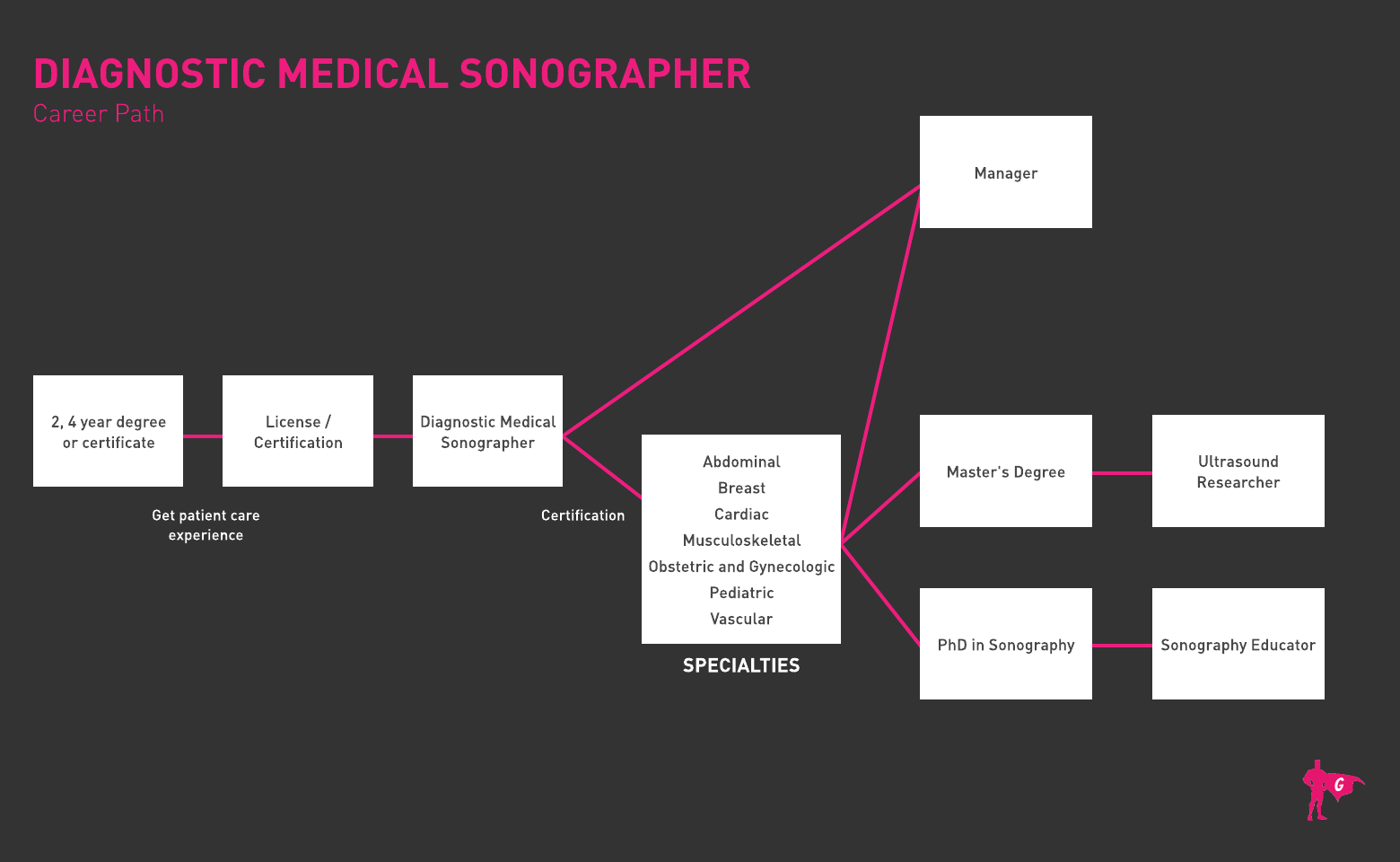Spotlights
Cardiac Sonographer, Cardiac/Vascular Sonographer, Diagnostic Medical Sonographer, Medical Sonographer, Registered Diagnostic Medical Sonographer (RDMS), Sonographer, Staff Sonographer, Ultrasonographer, Ultrasound Technician (Ultrasound Tech), Ultrasound Technologist (Ultrasound Tech)
A diagnostic medical sonographer produces ultrasonic recordings of internal organs for use by physicians. The images and test results help physicians assess and diagnose medical conditions.
- Help people find out what’s wrong with them
- Education and training is affordable.
- Job security
- Flexible hours
Diagnostic medical sonographers typically do the following:
- Prepare patients for procedures by taking their medical history and answering any questions about the procedure
- Prepare and maintain diagnostic imaging equipment
- Operate equipment to obtain diagnostic images or to conduct tests
- Review images or test results to check for quality and adequate coverage of the areas needed for diagnoses
- Recognize the difference between normal and abnormal images, and identify other diagnostic information
- Analyze diagnostic information to provide a summary of findings for physicians
- Record findings and keep track of patients’ records
Diagnostic medical sonographers specialize in creating images of the body’s organs and tissues. The images are known as sonograms or ultrasounds. Sonograms are often the first imaging tests performed when disease is suspected.
- Critical thinking
- Active listening
- Problem-solving
- Decision-making
Abdominal sonographers specialize in imaging a patient’s abdominal cavity and nearby organs, such as the kidney, liver, gallbladder, pancreas, or spleen. Abdominal sonographers may assist with biopsies or other examinations requiring ultrasound guidance.
Breast sonographers specialize in imaging a patient’s breast tissues. Sonography can confirm the presence of cysts and tumors that may have been detected by the patient, the physician, or a mammogram. Breast sonographers work closely with physicians and assist with procedures that track tumors and help to provide information that will aid doctors in making decisions about the best treatment options for breast cancer patients.
Cardiac sonographers (echocardiographers) specialize in imaging a patient’s heart. They use ultrasound equipment to examine the heart’s chambers, valves, and vessels. The images obtained are known as echocardiograms. An echocardiogram may be performed either while the patient is resting or after the patient has been physically active. Cardiac sonographers also may take echocardiograms of fetal hearts so that physicians can diagnose cardiac conditions during pregnancy. Cardiac sonographers work closely with physicians or surgeons before, during, and after procedures.
Musculoskeletal sonographers specialize in imaging muscles, ligaments, tendons, and joints. These sonographers may assist with ultrasound guidance for injections, or during surgical procedures, that deliver medication or treatment directly to affected tissues.
Pediatric sonographers specialize in imaging children and infants. Many of the medical conditions they image are associated with premature births or birth defects. Pediatric sonographers may work closely with pediatricians and other caregivers.
Obstetric and gynecologic sonographers specialize in imaging the female reproductive system. Many pregnant women receive sonograms to track the baby’s growth and health. Obstetrical sonographers work closely with physicians in detecting congenital birth defects.
Vascular technologists (vascular sonographers) create images of blood vessels and collect data that help physicians diagnose disorders affecting blood flow. Vascular technologists often measure a patient’s blood pressure and the volume of blood in their arms, legs, fingers, and toes in order to evaluate blood flow and identify blocked arteries or blood clots in the body.
- Hospitals
- Offices of physicians
- Medical and diagnostic laboratories
- Outpatient care centers
- May be on their feet for long periods and may need to lift or turn patients who are ill or disabled.
- May work evenings, weekends, or overnight because they work in facilities that are always open.
- Enjoyed solving puzzles and problems.
- Curious!
- Liked technology and learning about the new upgrades and advancements.
- Diagnostic Medical Sonographers require either a certificate, associate’s, or bachelor’s in sonography
- Certificate programs can be finished in as little as a year, but degrees may qualify you for higher pay
- Programs accredited by the Commission on Accreditation of Allied Health Education Programs are often preferred by employers
- Associate-level courses may include:
- Abdominal Scanning and Pathology
- OB/GYN Scanning and Pathology
- Principles of General Sonography
- Patient Care
- Ultrasound Physics and Instrumentation
- Vascular Scanning
- Bachelor’s curricula may include non-technical topics such as policy matters
- Students should expect to complete a supervised clinical component in a hospital or other setting
- In addition to completing college educational requirements, Diagnostic Medical Sonographers usually knock out a certification from one of the following organizations (either before or after taking a job):
- American Registry for Diagnostic Medical Sonographers - features certs in Musculoskeletal, Fetal Echocardiography, Adult Echocardiography, Sonography Principles, Vascular Technology, and more
- American Registry of Radiologic Technologists - features certs in Breast Sonography, Radiation Therapy, Bone Densitometry, Nuclear Medicine Technology, Cardiac Interventional Radiography, and more
- Cardiovascular Credentialing International - features certs in Advanced Cardiac Sonography, Phlebology, and more
- Other credentialing institutions are:
- Alliance for Physician Certification and Advancement - offers certs in Pediatric Sonography and Registered in Musculoskeletal Sonography
- American College of Chest Physicians - offers certs in Critical Care Ultrasonography and Point-of-Care Ultrasound
- Certification requirements vary but they all feature an exam. It’s not uncommon to earn more than one certification
- CPR/basic life support certification is usually necessary to get hired, too
- Most states don’t require licensure, but check with your school’s program and the state medical board to be sure
- In high school, students can prepare by taking preparatory classes such as biology (anatomy, physiology, microbiology), math, college algebra, physics, and English
- Shadow a medical sonographer to see if this is something you would be interested in
- Per O*Net, 47% of workers in this field have an associate’s, 19% have a post-secondary certificate, and 17% have a bachelor’s. Decide which educational route you want to go to get started, keeping in mind you can always return to school later!
- It may be helpful to volunteer in healthcare settings, which can look great on college applications and resumes!
- Learn about the importance of bedside manner when working with patients
- Request to do informational interviews with working Diagnostic Medical Sonographers! See if it’s possible to shadow on for a few hours at work
- Watch videos about the different types of specialization opportunities in this field
- Get your CPR/basic life support certification finished up and keep it current
- Get involved with professional organizations, read articles, learn the terminology, and stay up-to-date on the latest developments

- Many employers prefer to hire candidates who have a basic life support (BLS) certification, which affirms that they are trained to provide CPR.
- Sometimes it pays to just get started asap! Many Diagnostic Medical Sonographers start out working with a 1-year certificate and then later go on to complete a bachelor’s after they have gained work experience
- Diagnostic imaging personnel who are certified are expected to have the best job opportunities. Those certified in more than one specialty are expected to find even greater job opportunities.
- During your supervised clinical practice, try to make connections, grow your network, and ask about potential job openings you could slide into!
- ~78% of people in this field work in hospitals, so consider moving to an area with plenty of hospitals around!
- The states with the highest employment level in Diagnostic Medical Sonographers are California, Texas, New York, Florida, and Ohio
- The Bureau of Labor Statistics notes that many Sonographer jobs will be to diagnose medical conditions in older populations, so it could be useful to specialize in such areas
- Ask your school’s career center or your program manager for help with job placement, resume writing, and mock interviewing
- Check out sample Diagnostic Medical Sonographers resume templates. Make sure your resume if properly edited and error-free
- Get ready for interviews by reviewing commonly-asked questions and selecting a professional wardrobe
- Talk to professors and supervisors in advance to see if they can serve as personal references when you’re looking for work
- Sign up for alerts on Indeed, Simply Hired, and Glassdoor
Tips on how to advance and become a:
Manager
- Be a model employee
- When an opportunity comes, take it
- Don’t be afraid to ask for a promotion
Ultrasound Researcher
- For those who want to take an even more scientific approach to the bigger picture of sonography
- Pursue a higher degree in sonography
- Gain expertise in an ultrasound specialty
- Reach out to other ultrasound researchers
Sonography Educator
- For those who have love for education and sonography
- Earn a Master’s of PhD in sonography
- Consider skills needed to become an educator
- Minor in education as an undergraduate
Websites
- Alliance of Cardiovascular Professionals
- American Institute of Ultrasound in Medicine
- American Registry for Diagnostic Medical Sonography
- American Registry of Radiologic Technologists
- American Society of Echocardiography
- American Society of Radiologic Technologists
- Cardiovascular Credentialing International
- Commission on Accreditation of Allied Health Education Programs
- Society for Vascular Ultrasound
- Society of Diagnostic Medical Sonography
Books
- Textbook of Diagnostic Sonography, by Sandra L. Hagen-Ansert MS RDMS RDCS FASE FSDMS
- The Vascular System, Part of: Diagnostic Medical Sonography, by Ann Marie Kupinski
- Workbook for Diagnostic Medical Sonography: A Guide to Clinical Practice Obstetrics and Gynecology, by Susan Stephenson, Julia Dmitrieva, et al.
Newsfeed

Featured Jobs

Online Courses and Tools








